
China has great physical diversity. The eastern plain and southern coasts of the country consist of fertile lowlands and foothills. They are the location of most of China's agricultural output and human population. The southern areas of the country consist of hilly and mountainous terrain. The west and north of the country are dominated by sunken basins, rolling plateaus, and towering massifs. It contains part of the highest tableland on earth, the Tibetan Plateau, and has much lower agricultural potential and population.
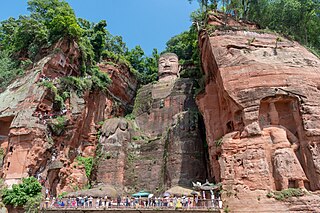
Sichuan is a province in Southwestern China, occupying the Sichuan Basin and Tibetan Plateau—between the Jinsha River to the west, the Daba Mountains to the north, and the Yunnan–Guizhou Plateau to the south. Its capital city is Chengdu, and its population stands at 83 million. Sichuan neighbors Qinghai and Gansu to the north, Shaanxi and Chongqing to the east, Guizhou and Yunnan to the south, and Tibet to the west.

Chongqing is a direct-administered municipality in Southwestern China. Chongqing is one of the four direct-administered municipalities under the Central People's Government, along with Beijing, Shanghai, and Tianjin. It is the only directly administrated municipality located deep inland. The municipality covers a large geographical area roughly the size of Austria, which includes several disjunct urban areas in addition to Chongqing proper. Due to its classification, the municipality of Chongqing is the largest city proper in the world by population, though Chongqing is not the most populous urban area.
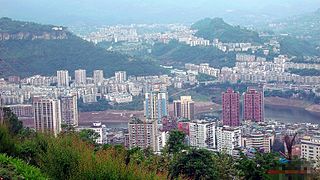
Wanzhou District is Chongqing's second most populated urban core area on the upper reaches of the Three Gorges of the Yangtze River in China. It is currently governed as a district of Chongqing Municipality, bordering Sichuan to the northwest and Hubei to the southeast. It was formerly known as Wanxian or Wan County. Prior to Chongqing's formation as a direct-controlled municipality, Wanzhou was part of Sichuan province. The urban core of Wanzhou is 228 km (142 mi) away from Chongqing's city proper.

Fuling District is a district in central Chongqing, China. As the second largest city in Chongqing, the area is known for zha cai, a hot pickled mustard tuber, as well as serving as the location of former U.S. Peace Corps teacher Peter Hessler's best-selling memoir River Town: Two Years on the Yangtze.

Yibin is a prefecture-level city in the southeastern part of Sichuan province, China, located at the junction of the Min and Yangtze Rivers. Its population was 4,588,804 inhabitants, according to the 2020 census, of whom 2,158,312 lived in the built-up area comprising three urban districts.

Yichang, alternatively romanized as Ichang, is a prefecture-level city located in western Hubei province, China. Yichang had a population of 3.92 million people at the 2022 census, making it the third most populous city in Hubei. The city is famous for the Three Gorges, the Three Gorges Dam and the Gezhouba Dam, all three of which are located in Yiling District, one of the city's districts.
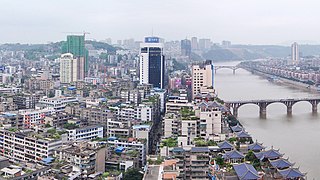
Luzhou (simplified Chinese: 泸州; traditional Chinese: 瀘州; pinyin: Lúzhōu; Sichuanese Pinyin: Nu2zou1; Luzhou dialect: ), formerly transliterated as Lu-chou or Luchow, is a prefecture-level city located in the southeast of Sichuan Province, China. It is also known as the "Liquor City" (酒城). It was named Jiangyang (simplified Chinese: 江阳; traditional Chinese: 江陽; pinyin: Jiāngyáng) until the Northern and Southern dynasties. Situated at the confluence of the Tuo River and the Yangtze River, Luzhou has been Sichuan province's largest port in both size and output since Chongqing's separation from Sichuan in 1997. As of the 2020 Chinese census, its population was 4,254,149. Of these, 1,241,273 lived in the built-up (or metro) area made of Jiangyang and Longmatan districts, as Naxi district is not conurbated yet. Luzhou borders Yunnan, Guizhou and Chongqing provinces. As the only geographic junction of the four provinces, it was an important port location in ancient China. After the PRC was founded in 1949, Luzhou became the capital of southern Sichuan province. In 1983, Luzhou was upgraded to prefecture-level city status.

Nanchong is a prefecture-level city in the northeast of Sichuan province, China, with an area of 12,479.96 km2 (4,818.54 sq mi). At the 2020 census it was home to 5,607,565 people, of whom 1,936,534 lived in the built-up area made of three urban districts. It is the second most populated city of Sichuan Province, after Chengdu. The administrative center is Shunqing District.

Zhaotong is a prefecture-level city located in the northeast corner of Yunnan province, China, bordering the provinces of Guizhou to the south and southeast and Sichuan to the northeast, north, and west.

Guang'an is a prefecture-level city in eastern Sichuan province. It is most famous as the birthplace of China's former paramount leader Deng Xiaoping. Guang'an lies between the hills of central Sichuan and the gorges area of the east. Guang'an is the only "Sichuan Chongqing Cooperation Demonstration Zone" in Sichuan and the nearest prefecture level city from the main city of Chongqing. It has been incorporated into the one-hour economic circle of Chongqing. Because of its strategic location, it is called the "Gateway to Eastern Sichuan". Its population, as of the 2020 census, was 3,254,883, of whom 976,370 lived in the built-up area made up of two urban districts.
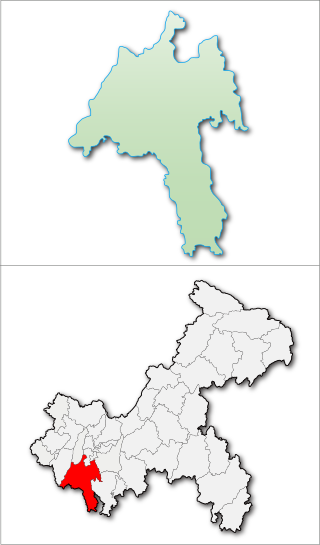
Jiangjin District, one of the districts in the southwest of Chongqing, China, lies along the upper reaches of Yangtze River, and has a history extending back more than 1500 years. The district covers 3200 square kilometres and has a population of 1,359,611 in 2020, and borders the provinces of Sichuan to the southwest and Guizhou to the south. The district government seat of Jiangjin District is 50 km (31 mi) away by highway, 65 km (40 mi) away by railway and 72 km (45 mi) away by waterway from Yuzhong District in central Chongqing.
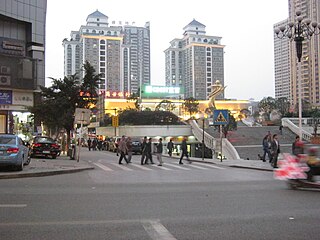
Yongchuan is a district of Chongqing, China, located by the north side of upper reach of Yangtze River, with a history of 1200 years. Yongchuan borders Sichuan province to the southwest and is 63 km (39 mi) away from Yuzhong District of central Chongqing and 276 km (171 mi) from Chengdu.
Three Gorges Reservoir Region, including 25 county-level divisions of Chongqing municipality and Hubei province, is the region directly or indirectly involved in the submersion of the water storage of the reservoir region of the Three Gorges Dam.
Lhünzhub, or Ganden Chökhor is a small town, the administrative center of Lhünzhub County in the Lhasa Prefecture of Tibet, China. It is located northeast of Lhasa.
Xixiu District is a district in the prefecture-level city of Anshun, Guizhou Province, China. The district spans an area of 1,705 square kilometres, and has a population of 765,399 people as of the 2010 Chinese Census.
The 2011 China floods were a series of floods from June to September 2011 that occurred in central and southern parts of the People's Republic of China. They were caused by heavy rain that inundated portions of 12 provinces, leaving other provinces still suffering a prolonged drought, and with direct economic losses of nearly US$6.5 billion.

The economy of Chongqing, China, has developed rapidly since it was separated from the Sichuan and became a centrally-administered municipality in 1997. In 2019, it was the sixth-largest Chinese city economy and ranked as China's third-largest municipal economy. In China's overall layout, Chongqing is also important for connecting China's underdeveloped western region with its more advanced eastern region, as well as promoting the economy of the mid-lower reaches of Yangtze river and the central western region.

In early June 2020, heavy rains caused by the regional rainy season led to floods severely affecting large areas of southern China including the Yangtze basin and its tributaries. Rains and floods extended to central and eastern China during July and were described as the worst since at least 1998.
Several floods caused by heavy rainfall struck in China starting in Guangdong Province in April 2024. Bands of heavy rainfall in June 2024 caused water levels to rise in rivers before moving northwards to other Southeastern and Central Chinese provinces, causing significantly raised water levels in the Yangtze River and the Pearl River Delta, inundating many towns and cities, forcing the relocation of hundreds of thousands of civilians, destroying several roads, structures, and farmland, and causing at least 71 deaths.














